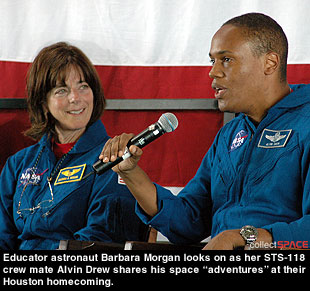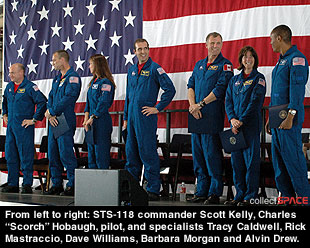|
|

|
Endeavour's crew returns home to Houston

August 22, 2007 — Teacher-turned-astronaut Barbara Morgan and her six Endeavour "classmates" returned to Houston Wednesday afternoon, the day after completing their orbital "field trip" with a landing at Kennedy Space Center in Florida. Awaiting their arrival at Ellington Field was a crowd of several hundred, including their families, friends, VIPs, NASA co-workers, and the public.
"The Endeavour has landed! And the Endeavour has landed safely!" proclaimed Texas Congresswoman Sheila Jackson Lee, who together with Representative Nick Lampson presented each of the STS-118 crew members with a Congressional Certificate of Excellence.
"Scott and Charlie, Tracy, Rick, Dave, Alvin and Barbara Morgan, we congratulate all of you all on a successful mission," said Lampson.
The crew, who flew back to Houston on a Gulfstream jet, took turns thanking their colleagues and sharing their thoughts about the 13-day mission from their seats on a stage set-up at the front of a hangar.
"This mission was a very exciting mission," said Dave Williams, who flew representing the Canadian Space Agency. "It had all the three main elements of exciting space flight: using cutting edge technology to continue building the space station; doing science and research in space; and also, that element that's dear to our hearts, education."
"I think the commitment to education on this mission was absolutely outstanding and it represents the desire of NASA to go forth and stimulate the next generation of space explorers, of researchers, of engineers who are going to take us back to the Moon and beyond. And there is no person better to do that than Barb Morgan," said Williams.
Morgan, who originally was chosen as back-up to Christa McAuliffe on the ill-fated 1986 Challenger mission, used part of her time aboard Endeavour to talk with students in her home state of Idaho and at the Challenger Center for Space Education, as well as flew millions of basil seeds for teachers to incorporate into an engineering challenge to design a plant growth chamber for the Moon's surface.
"You teachers are doing a great job making a difference for our young people, for their future and for all of our future," said Morgan while thanking the education offices and organizations that supported her flight. "With all of this, and with space exploration, I can't wait to see what comes next."
Joining Morgan for her live broadcasts from space was first time flyer Alvin Drew, who was a late addition to the crew due to changes in the manifest.
"I came late to this dance," joked Drew. "For me, this was an unexpected adventure, but an excellent adventure none the less. And I got to learn a few things, or re-learn a few things about adventures. First, is that they come in two separate parts: you have your destination and you've got your journey."
"For me the destination was obvious from day one, we were going to go add to the international space station and make it a better place. But the part that I hadn't focused on, the surprise lesson, was the journey itself."
The eighth crew member
Drew was added to the flight after it was decided to move astronaut Clay Anderson from STS-118 to the previous mission, beginning his stay on the station early. Though he was no longer part of their crew, Anderson still played a part in the success of Endeavour's mission.
"Special thanks to Clay Anderson," extended mission specialist Rick Mastraccio. "Clay is living on-board the space station right now and it takes a special person to live up there for four to six months."
"As you can imagine, we got there, seven people barging into your house and taking over your house for about a week or so and he was just so pleasant. He was just great. He helped us every step of the way," Mastraccio recalled.
For pilot Charles "Scorch" Hobaugh, this mission was his second visit to 'Clay's house'.
"My first flight was about six years ago and the station was pretty large at that time. The internal volume is pretty much the same as it's now but it has grown tremendously on the outside and has really increased its capability. It's got more internal capacity, more experiments going on, more real science going on," Hobaugh reflected.
Concern for their safety
Soon after Endeavour launched on Aug. 8, it was learned that a piece of insulating foam had come loose from the shuttle's external fuel tank and had struck the orbiter, causing a gouge in one of the heat shield tiles that line its belly. After running a battery of tests and computational models, as well as developing the procedures for a repair should one be necessary, mission managers came to the conclusion that Endeavour was safe to land "as is" — a decision that proved to be true despite public concern to the contrary.
"I want to say something about the public and I want to thank them for their interest and concern for our safety and we really appreciate that and we really appreciate the letters to the editor that we read and the e-mails that we get on their concern for our safety," STS-118 commander Scott Kelly said. "I also want you to know and the public to know that we as a crew, including the space station crew... never once doubted our leadership. We knew they were going to take the appropriate amount of time and use the appropriate analysis to make the right decision. And they did."
To arrive at that decision, flight controllers had the crew conduct a "focused inspection" of the damaged tile using the shuttle's robotic arm and a boom designed to extend the reach of its cameras.
"When you're asked to a do a focused inspection task it's rather daunting because not only have you never seen the procedures before, but the folks who have developed them stayed up all night to do them. And there were people staying up all night to double check what they did. Never before did I ever feel like a very close knit team as when we were handed procedures for the first time," said arm operator Tracy Caldwell.
"I want everybody to know who was involved with that on the shuttle robotic side, to know that we never felt like we were just three people up there looking outside. I took time and thought about the people that I know, and some of them are my very close friends, and knew that people were looking out after me," she said.
Though it was never carried out, a plan to repair the tile was devised, that would use the same arm and boom to support two spacewalkers, including Mastraccio.
"Dave and I and Tracy, we were ready to go do those tasks, we were ready to go pull the tools, we were familiar with the tools and techniques," he explained. "We were very comfortable going to do it, but we definitely did not want to go do it, so we are glad it worked out the way it did."
Building the future, achieving dreams

"This flight was not easy," explained Kelly. "Building a space station in space is probably one of the most complicated things we have ever done, in my opinion. It is a really, really magnificent place and it is something that our country needs if we ever want to venture beyond low Earth orbit. We're learning great things there, how to operate machines for a long period of time that will enable humans to live and work in space and understand how the human being itself can live and work in space for long periods of time. It is something that really is critical to us ever going back to the Moon and back to Mars."
"Like I said it wasn't easy," continued Kelly, "but we, not just us, but our colleagues out in the audience, the people that have trained us, the engineers and flight controllers and thousands of people around the country and abroad that work on this program, make it look easy."
They also made it look fun.
"I got into a little trouble with my wife because she said every time she would turn on the TV she saw me smiling on NASA Select. And she said, 'How come you never smile like that at home?' And I said, 'Well, it was the lack of gravity that just made it look like I was smiling. I really was not having any fun at all,'" said Mastraccio with a smile.
In the end though, for some of the crew, the mission was about accomplishing dreams.
"Dreams are something we all seem to have as kids, but as we grow older, somehow or other, we seem to lose the magic of those dreams. I think all of us on this crew would like to share with you that our commitment to this mission reflects our capability in believing in our dreams and trying to make our dreams come true," said Williams.
"If you ask me what it's like to have my dream come true, imagine yourself falling asleep 14 days straight, in the dark, with a big smile on your face that you can feel," first time flyer Caldwell shared. "That's a dream come true." |

© 2023 collectSPACE.com All rights reserved.
Questions? E-mail [email protected]

|
|

|

|
